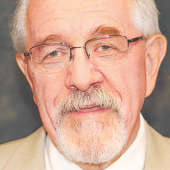- Christmas shopping is done, presents wrapped, strings attached? (12/14/16)
- Cecil is dead and human lives are threatened every day (8/12/15)
- As state flags go, Nebraska's ranks 50th (7/8/15)
- When everything looks like a nail (4/29/15)
- Who remembers to coal slurry pipeline debate? (3/11/15)
- More revelations in Department of Corrections mess (12/17/14)
- The Legislature becomes more Republican (11/19/14)
Opinion
Native Americans, rock legends and the pipeline saga
Thursday, October 9, 2014
Help me get my head around something here friends. There are nearly 21,000 miles of hazardous liquid and natural gas pipelines in Nebraska already. So what makes the battle over the latest one proposed -- the Keystone XL -- so special? Just asking.
Nearly 8,000 people gathered on an Antelope County farm on a beautiful fall Saturday afternoon to listen to music legends Willie Nelson and Neil Young perform. If you don't know these artists, stop reading right now. The crowds gathered in protest of the pipeline and in support of alternative energy proposals. They also saw members of several Native American tribes honor the musicians who have been familiar performers at the scattered series of Farm Aid concerts over the years.
The Nebraska Pipeline Association says the prairie is criss-crossed by interstate, intrastate, and distribution lines. Those pipelines may include large-diameter lines carrying energy products to population centers, as well as small-diameter lines that may deliver natural gas to businesses and households in your neighborhood, the Association says. The industry association calls pipelines the safest method for transporting energy products, but admits that when pipeline incidents occur they can present significant risks to the public and the environment.
The Nelson-Young concert and a number of protest-related activities have been sponsored by a group called Bold Nebraska. That group's activist leader Jane Kleeb says a report by University of Nebraska civil engineering professor John Stansbury predicts that there could be as many as 91 leaks in the anticipated 50-year lifespan of the Keystone XL pipeline if it is built. Stansbury apparently researched pipelines' history and TransCanada regulatory filings to predict that the leaks could potentially put 6.5 million gallons of tar sands oil in the Ogallala aquifer and essentially contaminate drinking water.
In May, TransCanada -- the company that wants to build the Keystone XL Pipeline -- submitted a revised route to the State Department, bypassing an original Sandhills route but still passing over parts of the massive aquifer. That action followed President Obama's rejection of the original route some months earlier.
Protestors have planted crops and built a barn and Native Americans have planted sacred grasses in the proposed path. The outdoor concert occurred on land near Neligh that also lies in the proposed path. While the Harvest of Hope Concert was going on, looking not-unlike a miniature Woodstock or another version of Farm Aid, thousands of other people were driving trucks with trailers and SUV's and station wagons along the multi-stop Junk Jaunt route from Arcadia to Wood River and a number of points (and towns starting with other letters of the alphabet) in between. The garage sale atmosphere in those communities was heart-warming as people turned the event into an outdoor fair. In fact, county fairgrounds in a number of those towns were crammed with flea market booths offering everything from homemade food to antiques and crafts.
I was driving in the Sandhills as well, enjoying the beauty of the crops and the trees and the sky filled with puffy white clouds on a day that was perfectly perched on the edge of fall. Occasionally I would see an orange and white pipe with a warning sign poking up several feet out of the ground, often at the edge of a pasture or near the rustling stalks of brown and nearly ready for harvest corn or soybeans. Over the years, I have come to recognize these as the indicator that pipelines are buried below.
Knowing this and seeing the passion of the folks who are protesting the Keystone XL, I have pause to wonder if we need another pipeline ... another threat to the peace and tranquility of the environment and the lifestyle we have come to appreciate in one of those mostly square states out west.
But I also have to ask if there is a political agenda or a social undertow that I do not recognize. It has been six long years since this pipeline was proposed. Hopefully we can see the matter resolved, one way or the other, sometime soon.

